Financial Planning and Policy Review in Health Management (PUN210)
VerifiedAdded on 2022/11/10
|8
|1789
|270
Homework Assignment
AI Summary
This assignment solution addresses key aspects of contemporary health management, focusing on the establishment and financial planning of a physiotherapy clinic in Brisbane. It outlines the budgeting process, including statistical budgets, expense budgets, revenue projections, operational budgets, and capital budgets, along with the types of accounts used for financial record-keeping. The assignment also examines healthcare funding in Australia, primarily through government initiatives, non-governmental organizations, and health insurance, and discusses the rise of activity-based funding. Furthermore, it details the steps in workforce planning, including defining staffing challenges, analyzing demand, identifying gaps, and finding solutions, while also addressing future challenges. Finally, the assignment explores the essentials of policy reviews, emphasizing issue identification, drafting, and circulation for feedback, along with the critical areas a policy should cover, such as hiring, performance management, working hours, and termination. The solution incorporates relevant references to support the analysis and recommendations.
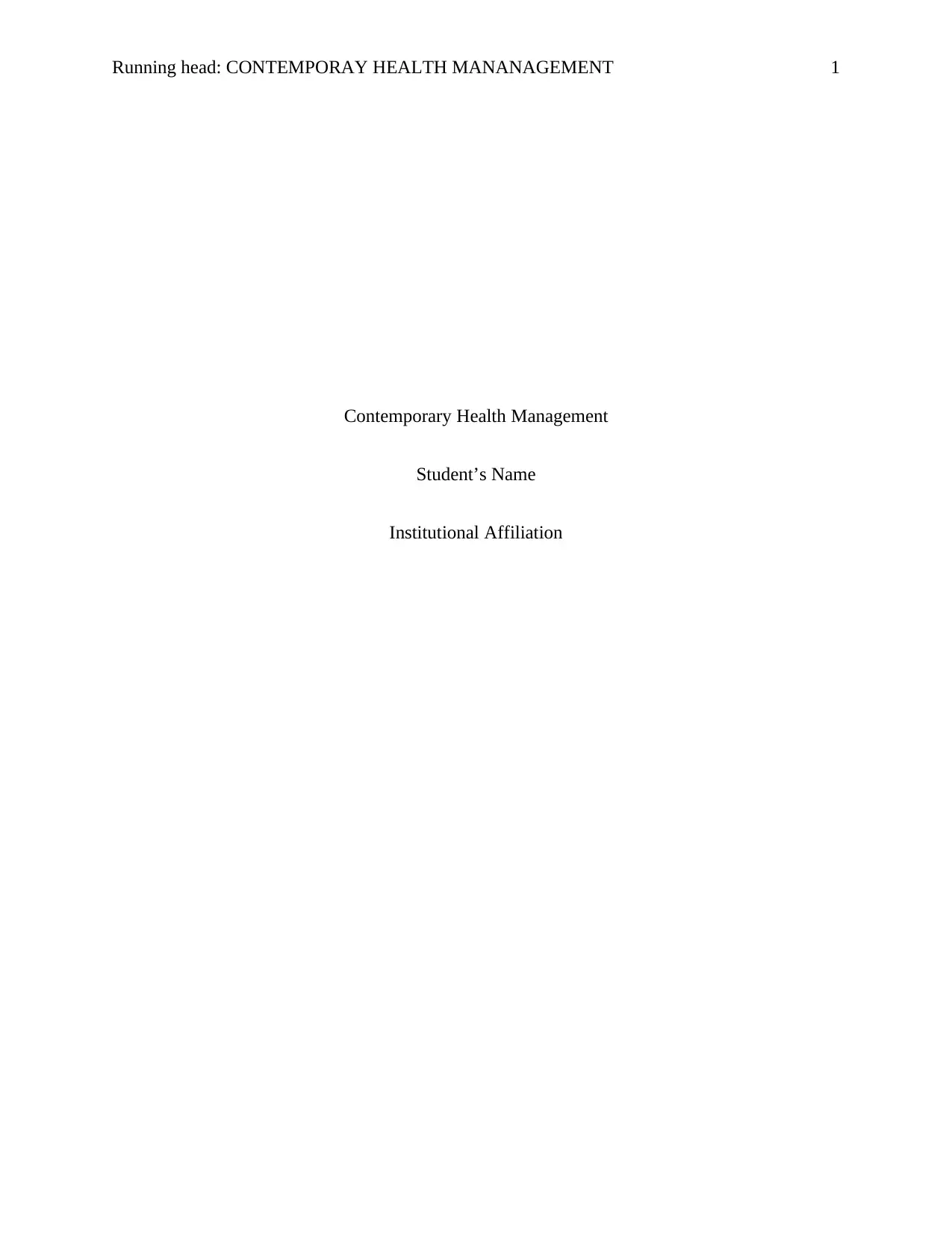
Running head: CONTEMPORAY HEALTH MANANAGEMENT 1
Contemporary Health Management
Student’s Name
Institutional Affiliation
Contemporary Health Management
Student’s Name
Institutional Affiliation
Paraphrase This Document
Need a fresh take? Get an instant paraphrase of this document with our AI Paraphraser
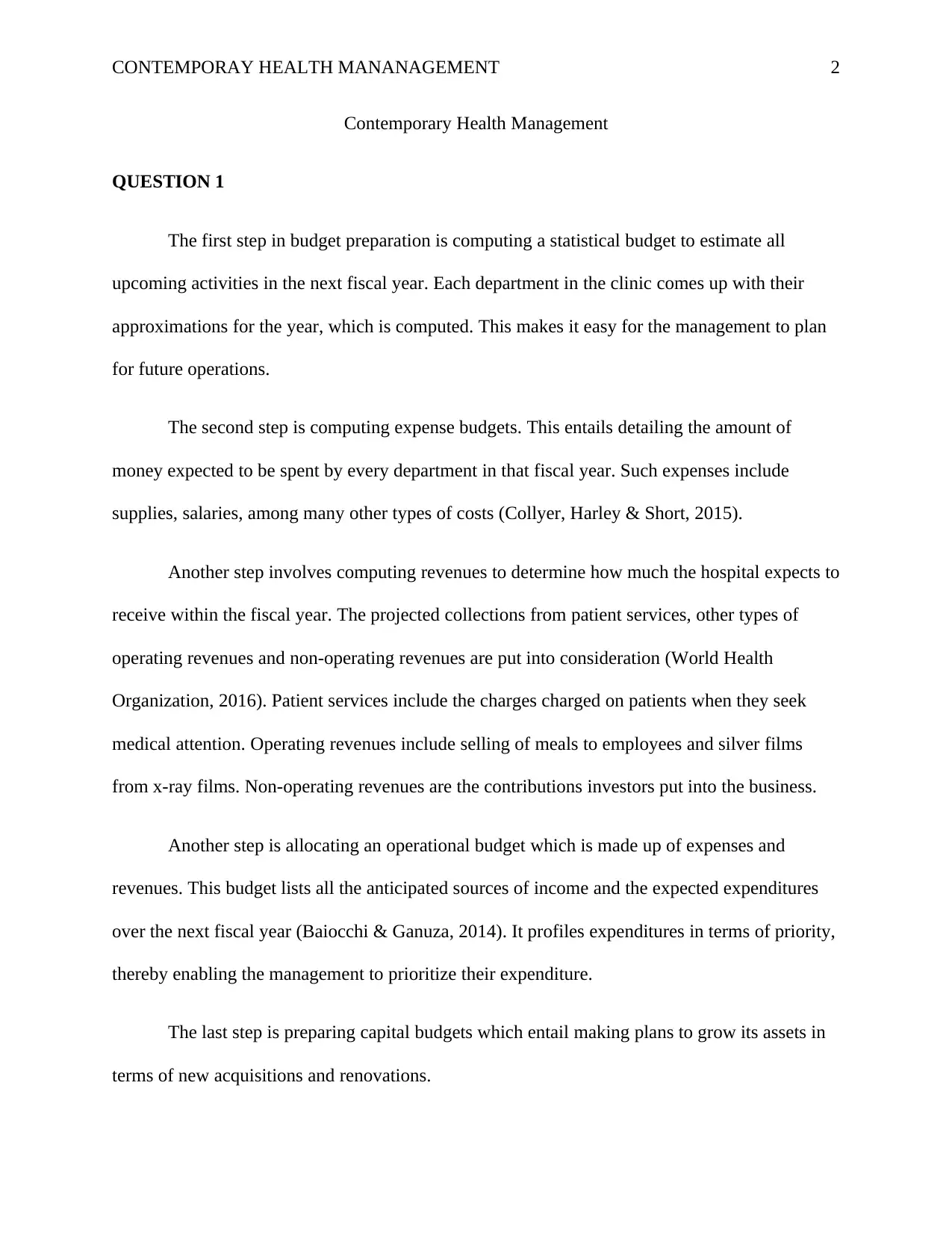
CONTEMPORAY HEALTH MANANAGEMENT 2
Contemporary Health Management
QUESTION 1
The first step in budget preparation is computing a statistical budget to estimate all
upcoming activities in the next fiscal year. Each department in the clinic comes up with their
approximations for the year, which is computed. This makes it easy for the management to plan
for future operations.
The second step is computing expense budgets. This entails detailing the amount of
money expected to be spent by every department in that fiscal year. Such expenses include
supplies, salaries, among many other types of costs (Collyer, Harley & Short, 2015).
Another step involves computing revenues to determine how much the hospital expects to
receive within the fiscal year. The projected collections from patient services, other types of
operating revenues and non-operating revenues are put into consideration (World Health
Organization, 2016). Patient services include the charges charged on patients when they seek
medical attention. Operating revenues include selling of meals to employees and silver films
from x-ray films. Non-operating revenues are the contributions investors put into the business.
Another step is allocating an operational budget which is made up of expenses and
revenues. This budget lists all the anticipated sources of income and the expected expenditures
over the next fiscal year (Baiocchi & Ganuza, 2014). It profiles expenditures in terms of priority,
thereby enabling the management to prioritize their expenditure.
The last step is preparing capital budgets which entail making plans to grow its assets in
terms of new acquisitions and renovations.
Contemporary Health Management
QUESTION 1
The first step in budget preparation is computing a statistical budget to estimate all
upcoming activities in the next fiscal year. Each department in the clinic comes up with their
approximations for the year, which is computed. This makes it easy for the management to plan
for future operations.
The second step is computing expense budgets. This entails detailing the amount of
money expected to be spent by every department in that fiscal year. Such expenses include
supplies, salaries, among many other types of costs (Collyer, Harley & Short, 2015).
Another step involves computing revenues to determine how much the hospital expects to
receive within the fiscal year. The projected collections from patient services, other types of
operating revenues and non-operating revenues are put into consideration (World Health
Organization, 2016). Patient services include the charges charged on patients when they seek
medical attention. Operating revenues include selling of meals to employees and silver films
from x-ray films. Non-operating revenues are the contributions investors put into the business.
Another step is allocating an operational budget which is made up of expenses and
revenues. This budget lists all the anticipated sources of income and the expected expenditures
over the next fiscal year (Baiocchi & Ganuza, 2014). It profiles expenditures in terms of priority,
thereby enabling the management to prioritize their expenditure.
The last step is preparing capital budgets which entail making plans to grow its assets in
terms of new acquisitions and renovations.
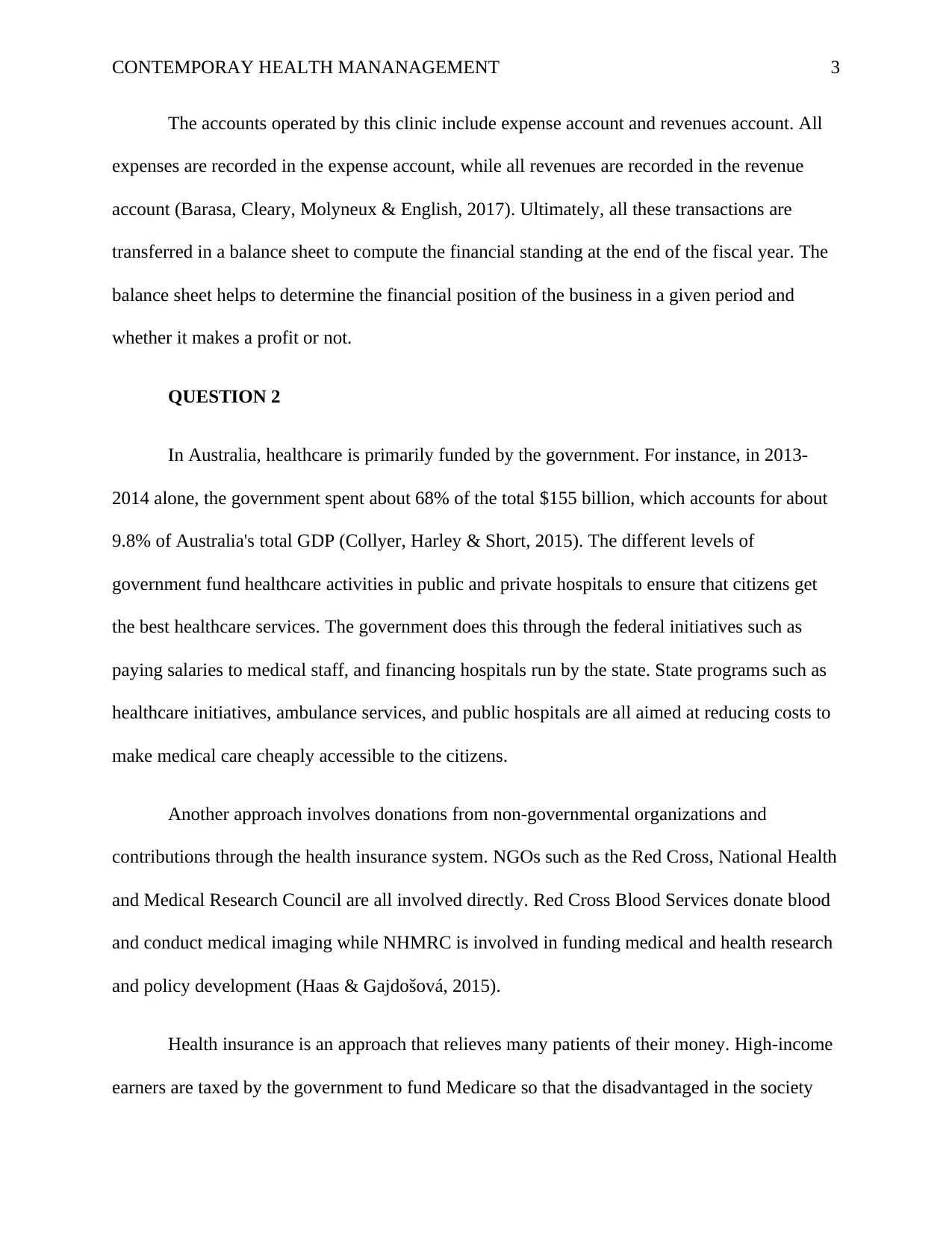
CONTEMPORAY HEALTH MANANAGEMENT 3
The accounts operated by this clinic include expense account and revenues account. All
expenses are recorded in the expense account, while all revenues are recorded in the revenue
account (Barasa, Cleary, Molyneux & English, 2017). Ultimately, all these transactions are
transferred in a balance sheet to compute the financial standing at the end of the fiscal year. The
balance sheet helps to determine the financial position of the business in a given period and
whether it makes a profit or not.
QUESTION 2
In Australia, healthcare is primarily funded by the government. For instance, in 2013-
2014 alone, the government spent about 68% of the total $155 billion, which accounts for about
9.8% of Australia's total GDP (Collyer, Harley & Short, 2015). The different levels of
government fund healthcare activities in public and private hospitals to ensure that citizens get
the best healthcare services. The government does this through the federal initiatives such as
paying salaries to medical staff, and financing hospitals run by the state. State programs such as
healthcare initiatives, ambulance services, and public hospitals are all aimed at reducing costs to
make medical care cheaply accessible to the citizens.
Another approach involves donations from non-governmental organizations and
contributions through the health insurance system. NGOs such as the Red Cross, National Health
and Medical Research Council are all involved directly. Red Cross Blood Services donate blood
and conduct medical imaging while NHMRC is involved in funding medical and health research
and policy development (Haas & Gajdošová, 2015).
Health insurance is an approach that relieves many patients of their money. High-income
earners are taxed by the government to fund Medicare so that the disadvantaged in the society
The accounts operated by this clinic include expense account and revenues account. All
expenses are recorded in the expense account, while all revenues are recorded in the revenue
account (Barasa, Cleary, Molyneux & English, 2017). Ultimately, all these transactions are
transferred in a balance sheet to compute the financial standing at the end of the fiscal year. The
balance sheet helps to determine the financial position of the business in a given period and
whether it makes a profit or not.
QUESTION 2
In Australia, healthcare is primarily funded by the government. For instance, in 2013-
2014 alone, the government spent about 68% of the total $155 billion, which accounts for about
9.8% of Australia's total GDP (Collyer, Harley & Short, 2015). The different levels of
government fund healthcare activities in public and private hospitals to ensure that citizens get
the best healthcare services. The government does this through the federal initiatives such as
paying salaries to medical staff, and financing hospitals run by the state. State programs such as
healthcare initiatives, ambulance services, and public hospitals are all aimed at reducing costs to
make medical care cheaply accessible to the citizens.
Another approach involves donations from non-governmental organizations and
contributions through the health insurance system. NGOs such as the Red Cross, National Health
and Medical Research Council are all involved directly. Red Cross Blood Services donate blood
and conduct medical imaging while NHMRC is involved in funding medical and health research
and policy development (Haas & Gajdošová, 2015).
Health insurance is an approach that relieves many patients of their money. High-income
earners are taxed by the government to fund Medicare so that the disadvantaged in the society
⊘ This is a preview!⊘
Do you want full access?
Subscribe today to unlock all pages.

Trusted by 1+ million students worldwide
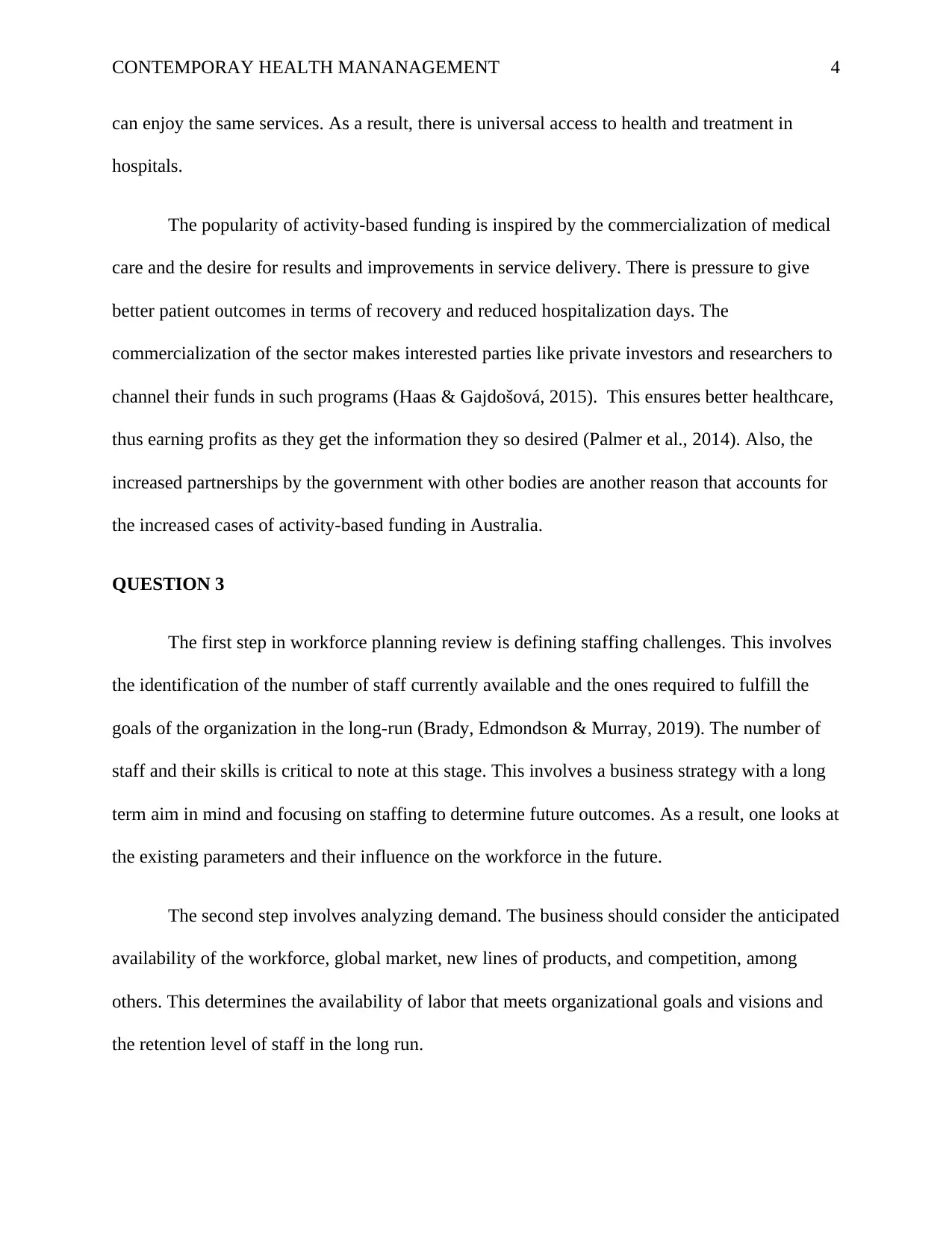
CONTEMPORAY HEALTH MANANAGEMENT 4
can enjoy the same services. As a result, there is universal access to health and treatment in
hospitals.
The popularity of activity-based funding is inspired by the commercialization of medical
care and the desire for results and improvements in service delivery. There is pressure to give
better patient outcomes in terms of recovery and reduced hospitalization days. The
commercialization of the sector makes interested parties like private investors and researchers to
channel their funds in such programs (Haas & Gajdošová, 2015). This ensures better healthcare,
thus earning profits as they get the information they so desired (Palmer et al., 2014). Also, the
increased partnerships by the government with other bodies are another reason that accounts for
the increased cases of activity-based funding in Australia.
QUESTION 3
The first step in workforce planning review is defining staffing challenges. This involves
the identification of the number of staff currently available and the ones required to fulfill the
goals of the organization in the long-run (Brady, Edmondson & Murray, 2019). The number of
staff and their skills is critical to note at this stage. This involves a business strategy with a long
term aim in mind and focusing on staffing to determine future outcomes. As a result, one looks at
the existing parameters and their influence on the workforce in the future.
The second step involves analyzing demand. The business should consider the anticipated
availability of the workforce, global market, new lines of products, and competition, among
others. This determines the availability of labor that meets organizational goals and visions and
the retention level of staff in the long run.
can enjoy the same services. As a result, there is universal access to health and treatment in
hospitals.
The popularity of activity-based funding is inspired by the commercialization of medical
care and the desire for results and improvements in service delivery. There is pressure to give
better patient outcomes in terms of recovery and reduced hospitalization days. The
commercialization of the sector makes interested parties like private investors and researchers to
channel their funds in such programs (Haas & Gajdošová, 2015). This ensures better healthcare,
thus earning profits as they get the information they so desired (Palmer et al., 2014). Also, the
increased partnerships by the government with other bodies are another reason that accounts for
the increased cases of activity-based funding in Australia.
QUESTION 3
The first step in workforce planning review is defining staffing challenges. This involves
the identification of the number of staff currently available and the ones required to fulfill the
goals of the organization in the long-run (Brady, Edmondson & Murray, 2019). The number of
staff and their skills is critical to note at this stage. This involves a business strategy with a long
term aim in mind and focusing on staffing to determine future outcomes. As a result, one looks at
the existing parameters and their influence on the workforce in the future.
The second step involves analyzing demand. The business should consider the anticipated
availability of the workforce, global market, new lines of products, and competition, among
others. This determines the availability of labor that meets organizational goals and visions and
the retention level of staff in the long run.
Paraphrase This Document
Need a fresh take? Get an instant paraphrase of this document with our AI Paraphraser
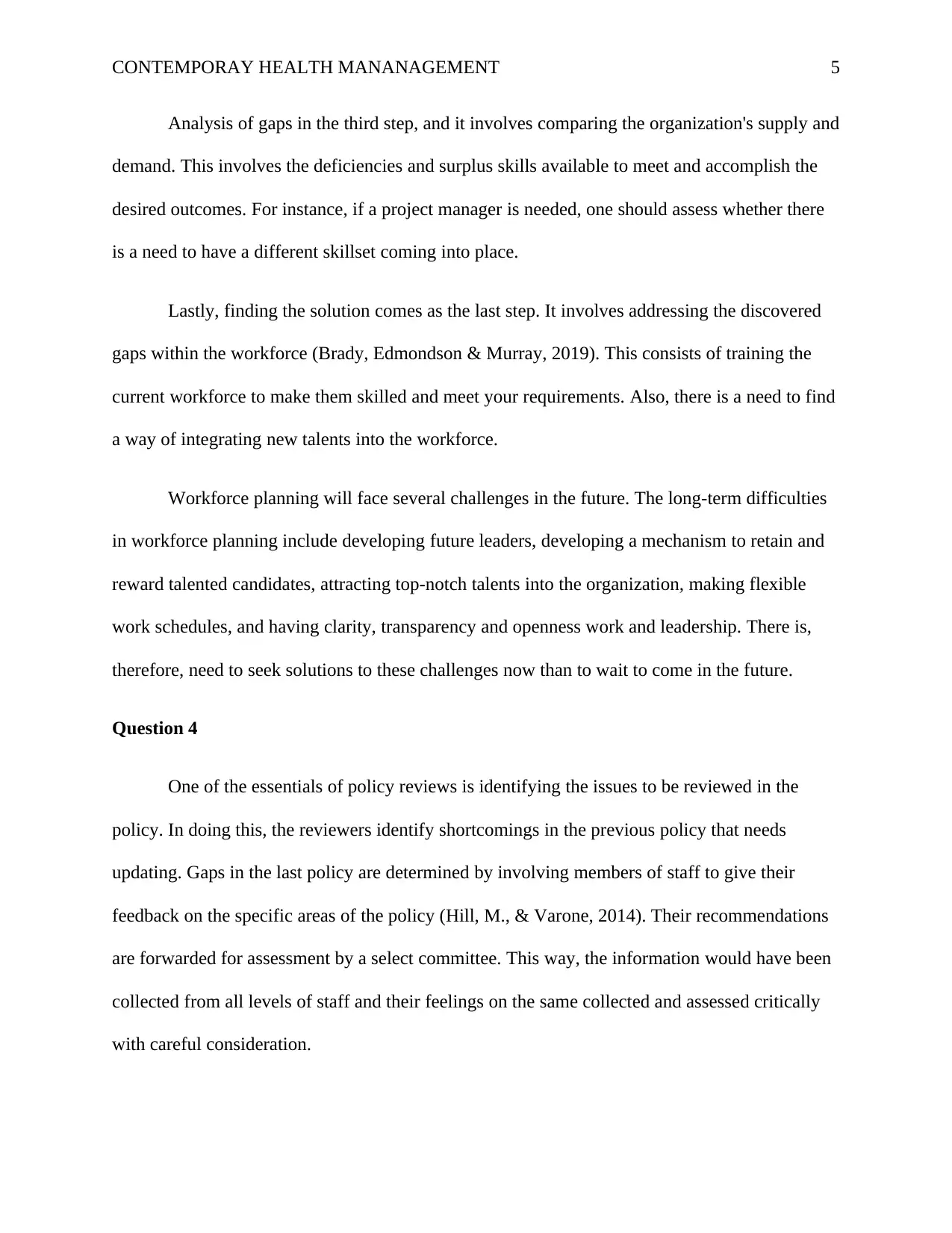
CONTEMPORAY HEALTH MANANAGEMENT 5
Analysis of gaps in the third step, and it involves comparing the organization's supply and
demand. This involves the deficiencies and surplus skills available to meet and accomplish the
desired outcomes. For instance, if a project manager is needed, one should assess whether there
is a need to have a different skillset coming into place.
Lastly, finding the solution comes as the last step. It involves addressing the discovered
gaps within the workforce (Brady, Edmondson & Murray, 2019). This consists of training the
current workforce to make them skilled and meet your requirements. Also, there is a need to find
a way of integrating new talents into the workforce.
Workforce planning will face several challenges in the future. The long-term difficulties
in workforce planning include developing future leaders, developing a mechanism to retain and
reward talented candidates, attracting top-notch talents into the organization, making flexible
work schedules, and having clarity, transparency and openness work and leadership. There is,
therefore, need to seek solutions to these challenges now than to wait to come in the future.
Question 4
One of the essentials of policy reviews is identifying the issues to be reviewed in the
policy. In doing this, the reviewers identify shortcomings in the previous policy that needs
updating. Gaps in the last policy are determined by involving members of staff to give their
feedback on the specific areas of the policy (Hill, M., & Varone, 2014). Their recommendations
are forwarded for assessment by a select committee. This way, the information would have been
collected from all levels of staff and their feelings on the same collected and assessed critically
with careful consideration.
Analysis of gaps in the third step, and it involves comparing the organization's supply and
demand. This involves the deficiencies and surplus skills available to meet and accomplish the
desired outcomes. For instance, if a project manager is needed, one should assess whether there
is a need to have a different skillset coming into place.
Lastly, finding the solution comes as the last step. It involves addressing the discovered
gaps within the workforce (Brady, Edmondson & Murray, 2019). This consists of training the
current workforce to make them skilled and meet your requirements. Also, there is a need to find
a way of integrating new talents into the workforce.
Workforce planning will face several challenges in the future. The long-term difficulties
in workforce planning include developing future leaders, developing a mechanism to retain and
reward talented candidates, attracting top-notch talents into the organization, making flexible
work schedules, and having clarity, transparency and openness work and leadership. There is,
therefore, need to seek solutions to these challenges now than to wait to come in the future.
Question 4
One of the essentials of policy reviews is identifying the issues to be reviewed in the
policy. In doing this, the reviewers identify shortcomings in the previous policy that needs
updating. Gaps in the last policy are determined by involving members of staff to give their
feedback on the specific areas of the policy (Hill, M., & Varone, 2014). Their recommendations
are forwarded for assessment by a select committee. This way, the information would have been
collected from all levels of staff and their feelings on the same collected and assessed critically
with careful consideration.
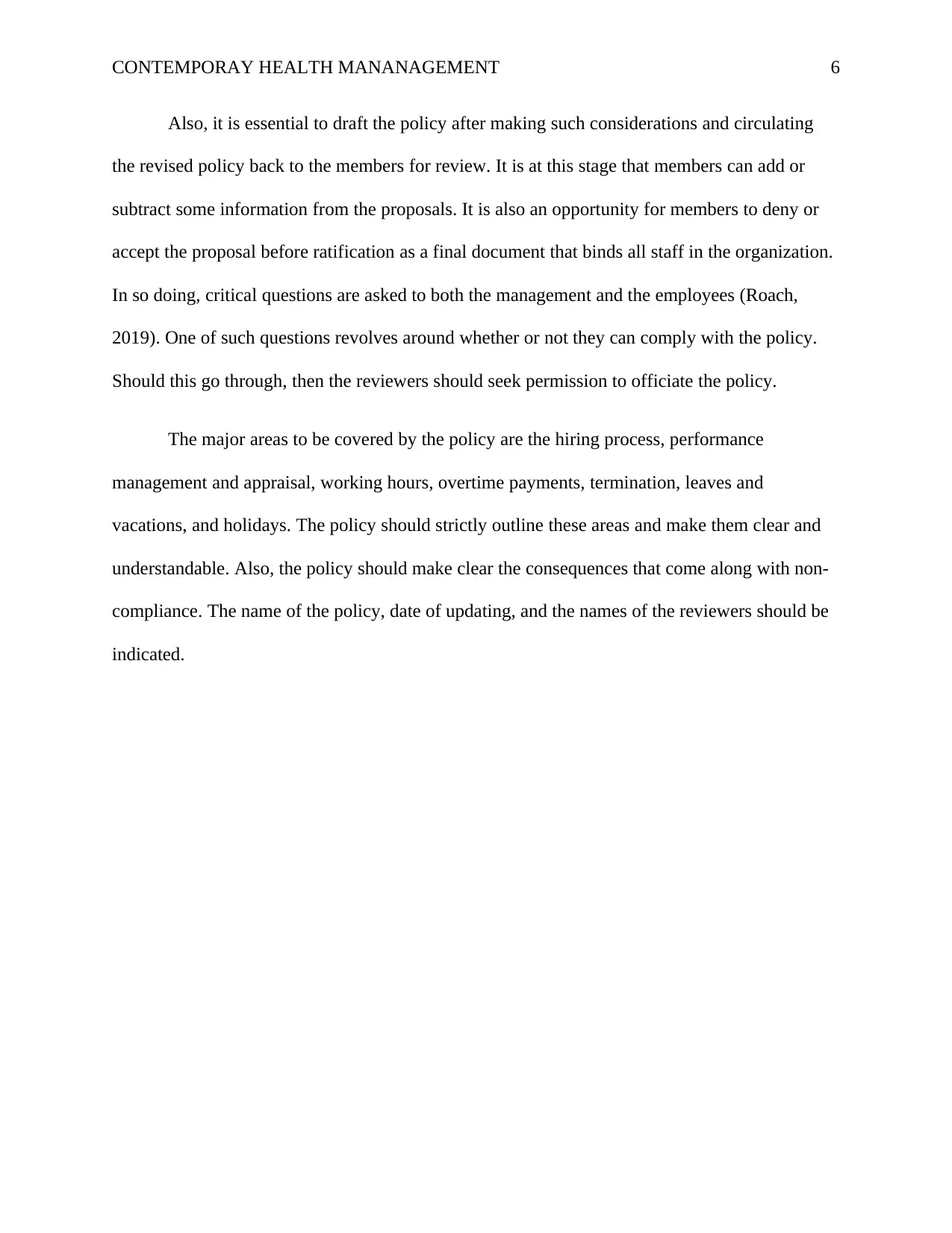
CONTEMPORAY HEALTH MANANAGEMENT 6
Also, it is essential to draft the policy after making such considerations and circulating
the revised policy back to the members for review. It is at this stage that members can add or
subtract some information from the proposals. It is also an opportunity for members to deny or
accept the proposal before ratification as a final document that binds all staff in the organization.
In so doing, critical questions are asked to both the management and the employees (Roach,
2019). One of such questions revolves around whether or not they can comply with the policy.
Should this go through, then the reviewers should seek permission to officiate the policy.
The major areas to be covered by the policy are the hiring process, performance
management and appraisal, working hours, overtime payments, termination, leaves and
vacations, and holidays. The policy should strictly outline these areas and make them clear and
understandable. Also, the policy should make clear the consequences that come along with non-
compliance. The name of the policy, date of updating, and the names of the reviewers should be
indicated.
Also, it is essential to draft the policy after making such considerations and circulating
the revised policy back to the members for review. It is at this stage that members can add or
subtract some information from the proposals. It is also an opportunity for members to deny or
accept the proposal before ratification as a final document that binds all staff in the organization.
In so doing, critical questions are asked to both the management and the employees (Roach,
2019). One of such questions revolves around whether or not they can comply with the policy.
Should this go through, then the reviewers should seek permission to officiate the policy.
The major areas to be covered by the policy are the hiring process, performance
management and appraisal, working hours, overtime payments, termination, leaves and
vacations, and holidays. The policy should strictly outline these areas and make them clear and
understandable. Also, the policy should make clear the consequences that come along with non-
compliance. The name of the policy, date of updating, and the names of the reviewers should be
indicated.
⊘ This is a preview!⊘
Do you want full access?
Subscribe today to unlock all pages.

Trusted by 1+ million students worldwide
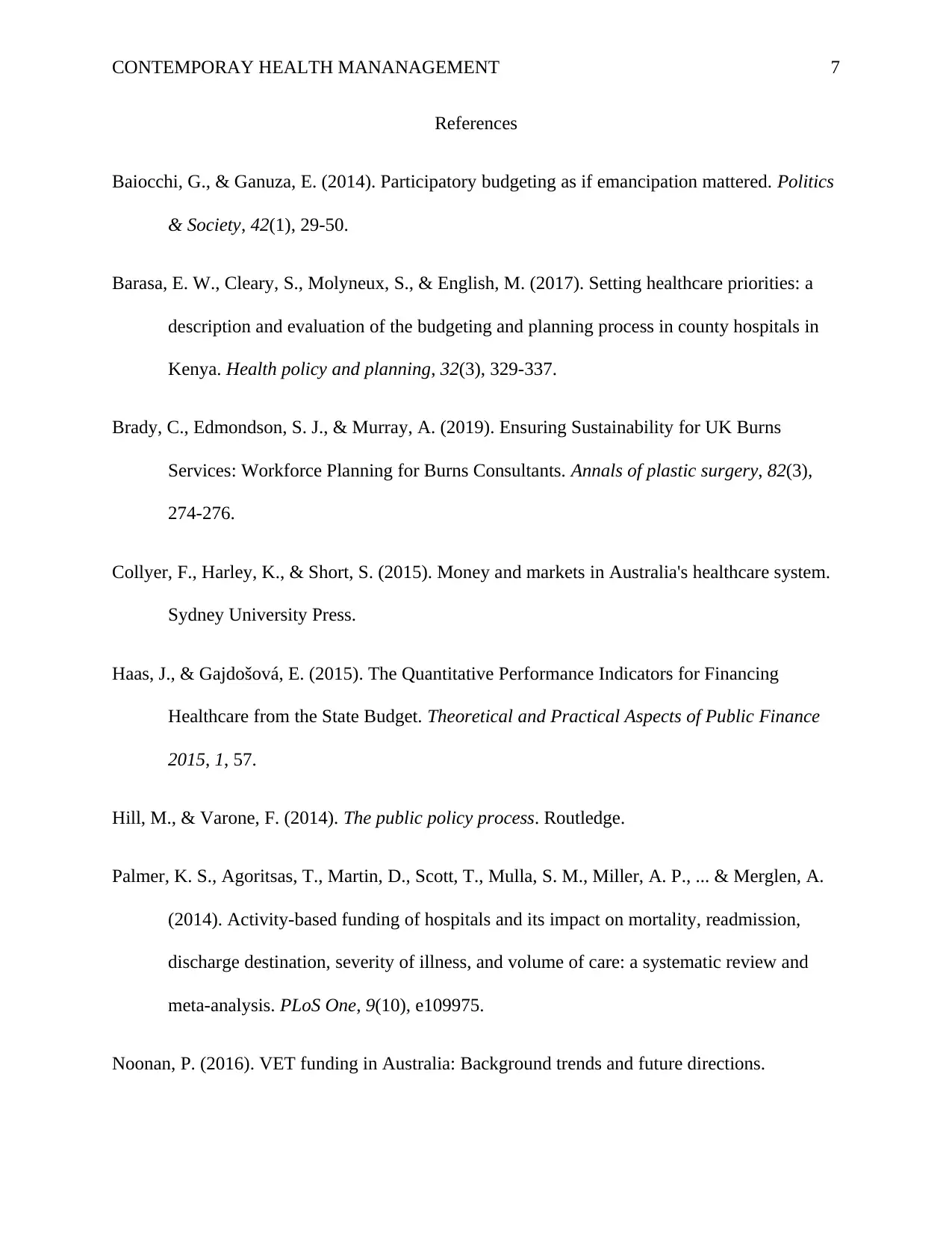
CONTEMPORAY HEALTH MANANAGEMENT 7
References
Baiocchi, G., & Ganuza, E. (2014). Participatory budgeting as if emancipation mattered. Politics
& Society, 42(1), 29-50.
Barasa, E. W., Cleary, S., Molyneux, S., & English, M. (2017). Setting healthcare priorities: a
description and evaluation of the budgeting and planning process in county hospitals in
Kenya. Health policy and planning, 32(3), 329-337.
Brady, C., Edmondson, S. J., & Murray, A. (2019). Ensuring Sustainability for UK Burns
Services: Workforce Planning for Burns Consultants. Annals of plastic surgery, 82(3),
274-276.
Collyer, F., Harley, K., & Short, S. (2015). Money and markets in Australia's healthcare system.
Sydney University Press.
Haas, J., & Gajdošová, E. (2015). The Quantitative Performance Indicators for Financing
Healthcare from the State Budget. Theoretical and Practical Aspects of Public Finance
2015, 1, 57.
Hill, M., & Varone, F. (2014). The public policy process. Routledge.
Palmer, K. S., Agoritsas, T., Martin, D., Scott, T., Mulla, S. M., Miller, A. P., ... & Merglen, A.
(2014). Activity-based funding of hospitals and its impact on mortality, readmission,
discharge destination, severity of illness, and volume of care: a systematic review and
meta-analysis. PLoS One, 9(10), e109975.
Noonan, P. (2016). VET funding in Australia: Background trends and future directions.
References
Baiocchi, G., & Ganuza, E. (2014). Participatory budgeting as if emancipation mattered. Politics
& Society, 42(1), 29-50.
Barasa, E. W., Cleary, S., Molyneux, S., & English, M. (2017). Setting healthcare priorities: a
description and evaluation of the budgeting and planning process in county hospitals in
Kenya. Health policy and planning, 32(3), 329-337.
Brady, C., Edmondson, S. J., & Murray, A. (2019). Ensuring Sustainability for UK Burns
Services: Workforce Planning for Burns Consultants. Annals of plastic surgery, 82(3),
274-276.
Collyer, F., Harley, K., & Short, S. (2015). Money and markets in Australia's healthcare system.
Sydney University Press.
Haas, J., & Gajdošová, E. (2015). The Quantitative Performance Indicators for Financing
Healthcare from the State Budget. Theoretical and Practical Aspects of Public Finance
2015, 1, 57.
Hill, M., & Varone, F. (2014). The public policy process. Routledge.
Palmer, K. S., Agoritsas, T., Martin, D., Scott, T., Mulla, S. M., Miller, A. P., ... & Merglen, A.
(2014). Activity-based funding of hospitals and its impact on mortality, readmission,
discharge destination, severity of illness, and volume of care: a systematic review and
meta-analysis. PLoS One, 9(10), e109975.
Noonan, P. (2016). VET funding in Australia: Background trends and future directions.
Paraphrase This Document
Need a fresh take? Get an instant paraphrase of this document with our AI Paraphraser
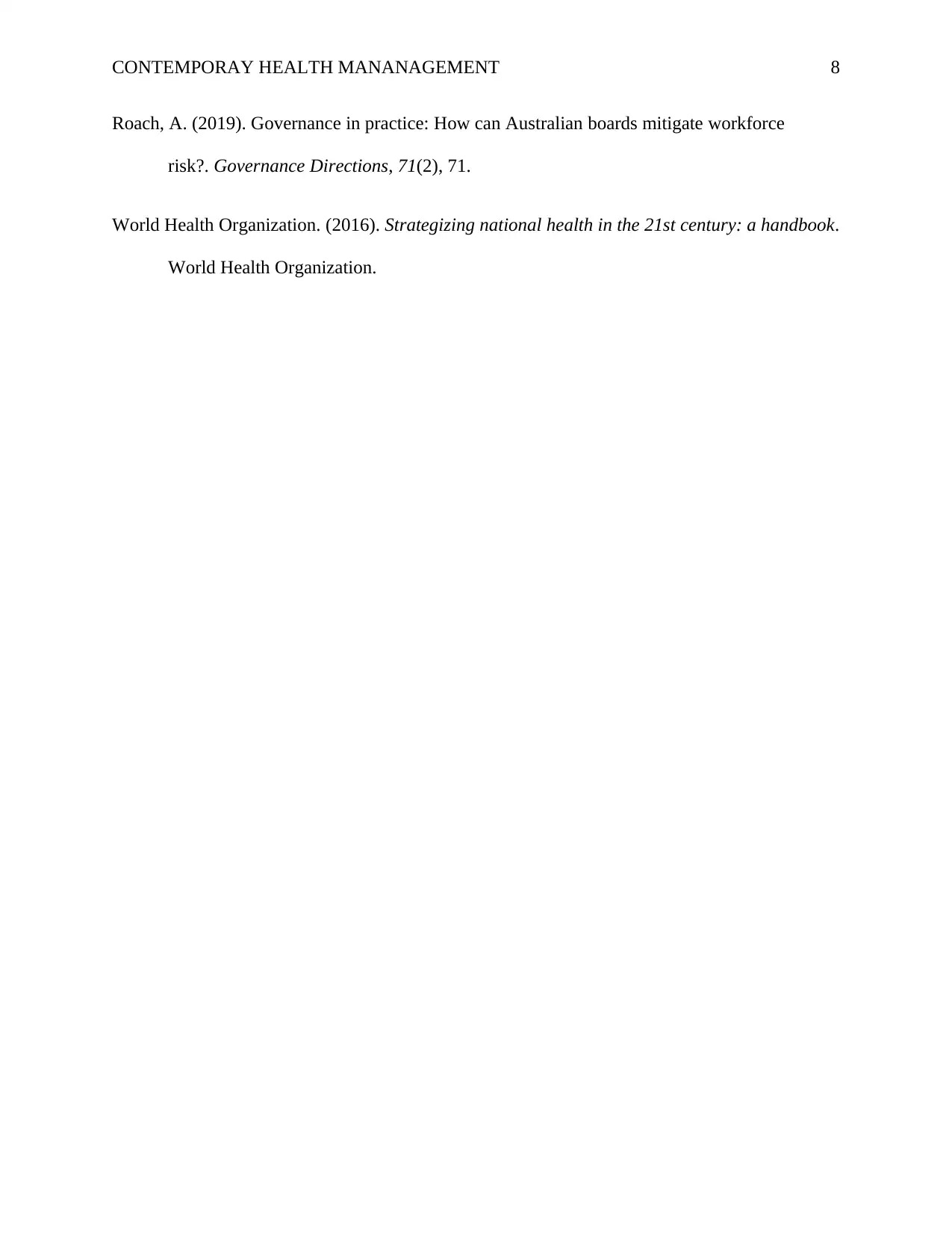
CONTEMPORAY HEALTH MANANAGEMENT 8
Roach, A. (2019). Governance in practice: How can Australian boards mitigate workforce
risk?. Governance Directions, 71(2), 71.
World Health Organization. (2016). Strategizing national health in the 21st century: a handbook.
World Health Organization.
Roach, A. (2019). Governance in practice: How can Australian boards mitigate workforce
risk?. Governance Directions, 71(2), 71.
World Health Organization. (2016). Strategizing national health in the 21st century: a handbook.
World Health Organization.
1 out of 8
Related Documents
Your All-in-One AI-Powered Toolkit for Academic Success.
+13062052269
info@desklib.com
Available 24*7 on WhatsApp / Email
![[object Object]](/_next/static/media/star-bottom.7253800d.svg)
Unlock your academic potential
Copyright © 2020–2025 A2Z Services. All Rights Reserved. Developed and managed by ZUCOL.




